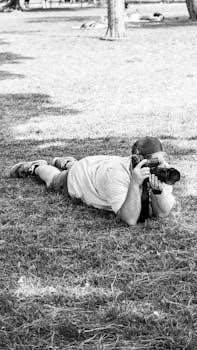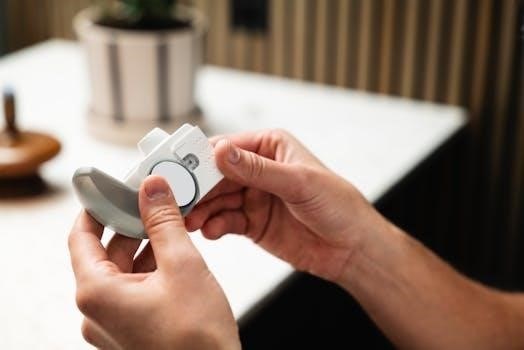The 54321 grounding technique is a mindfulness exercise designed to manage stress and anxiety by reconnecting you with your immediate environment. It utilizes five senses to help anchor you in the present moment.
What is the 54321 Grounding Technique?
The 54321 grounding technique is a simple yet powerful sensory-based method used to manage anxiety and stress; It’s a mindfulness exercise that involves engaging your five senses to bring you back to the present. This technique helps to disrupt the cycle of anxious thoughts by shifting your focus from internal worries to the external world. By systematically identifying things you can see, touch, hear, smell, and taste, you anchor yourself in the here and now. This process can effectively calm the body’s fight-or-flight response, promoting a sense of balance and control during stressful or overwhelming situations. It can be used anytime, anywhere, making it a readily accessible tool for emotional regulation.
How the 54321 Technique Works
This technique works by engaging your senses, shifting focus away from anxious thoughts and grounding you in the present. It promotes mindfulness and improves emotional regulation through sensory awareness.
Engaging the Five Senses
The 54321 technique actively engages your five senses—sight, touch, hearing, smell, and taste—to bring your awareness to the present. By focusing on specific sensory inputs, it interrupts the cycle of anxious thoughts. This sensory engagement helps to ground you by making you more aware of your surroundings. Each sense is systematically explored, starting with things you can see, then progressing to touch, hearing, smell, and finally, taste. This structured approach makes it easier to shift your focus from internal worries to external stimuli, creating a sense of calm and control by experiencing the present moment.
Shifting Focus from Anxious Thoughts
The 54321 grounding technique is designed to effectively shift your focus away from anxious thoughts by actively engaging your senses. When you are feeling overwhelmed, your mind may be racing with worries, but by concentrating on external stimuli, you break free from this mental loop. This method redirects your attention to the tangible aspects of your environment, such as the colors you see, the textures you feel, and the sounds you hear. This deliberate shift from internal anxieties to external sensory details helps to reduce the intensity of overwhelming emotions, and helps to re-establish a sense of calm and control.

Steps of the 54321 Technique
The 54321 technique involves a series of steps, each engaging a different sense. These steps guide you to focus on what you see, touch, hear, smell, and taste.
Identifying 5 Things You Can See
To begin, focus your attention on your surroundings and identify five distinct things you can see. Don’t just glance; really observe each item, noticing its size, shape, and color. Take a mental note of how each object relates to its environment. This step helps ground you in the present by drawing your focus to the details of your immediate space. You might see a lamp, a book, a window, a plant, or a piece of furniture. The goal is to consciously acknowledge the visual details and bring your awareness to the here and now.
Identifying 4 Things You Can Touch
Next, shift your focus to the sense of touch and identify four different things you can physically feel. Engage with each item, noticing its texture and temperature. Is it soft, rough, smooth, or bumpy? Is it warm, cool, or cold? You might touch your clothing, a nearby table, a pen, or your own skin. Pay attention to the sensations as you make contact with each object. This step helps you connect to your physical self and further grounds you in the present by engaging your tactile senses.
Identifying 3 Things You Can Hear
Now, turn your attention to the sounds around you and pinpoint three distinct things you can hear. These could be sounds from the environment or from other people. Maybe you hear the hum of an air conditioner, the distant traffic, or the chirp of a bird. Listen carefully, distinguishing one sound from another. Try to move beyond the loudest sounds and notice the subtle ones. Focusing on these auditory details draws your attention away from anxious thoughts and into your immediate surroundings. This step engages your hearing and helps bring you further into the present moment.
Identifying 2 Things You Can Smell
Next, shift your focus to your sense of smell and try to identify two distinct odors. This can be challenging, but even subtle scents can be grounding. Perhaps you notice the fragrance of your hand lotion, the smell of coffee, or even the faint scent of your own clothes. If no obvious smells are present, you can use an essential oil or hand sanitizer. Consciously noticing these smells helps you to further engage with your environment and move away from anxious thoughts. This action also encourages you to become more mindful of your surroundings.
Identifying 1 Thing You Can Taste
Finally, bring your attention to your sense of taste and identify one thing you can taste. This could be a piece of gum, a mint, or a sip of your drink. If you don’t have anything available to create a taste, you can simply focus on the taste in your mouth. Notice any lingering flavors or the feeling in your mouth. This action engages your last sense, providing a full sensory experience and further helping you to return to the present moment and manage feelings of anxiety.

Benefits of the 54321 Technique
The 54321 technique offers numerous benefits, including reducing anxiety, improving emotional regulation, and promoting mindfulness by focusing on sensory experiences and the present moment.
Reducing Anxiety and Panic Attacks
The 54321 grounding technique is highly effective at reducing anxiety and panic attacks by anchoring individuals to the present moment. By engaging the five senses, it interrupts the cycle of overwhelming thoughts and sensations, helping to regain a sense of calm and control; When feeling overwhelmed or anxious, this method brings your thoughts back to the present. This immediate relief is invaluable during acute stress and panic episodes. The technique focuses on what’s happening around you rather than the anxious feelings, which helps to calm the fight or flight response. It’s a practical way to shift focus and achieve a balanced state of mind.
Improving Emotional Regulation
Regular practice of the 54321 grounding technique can significantly improve emotional regulation. This is because the exercise empowers you to take control of your mental state, making you feel more confident in confronting and handling emotional challenges. It helps to shift your focus from internal emotional turmoil to the external environment, allowing you to regain control over your feelings. This technique provides a structured way to manage intense emotions by engaging the senses, which can create a feeling of stability and calm. By using this method regularly, individuals can develop a stronger sense of self-control and better manage emotional responses.
Promoting Mindfulness
The 54321 grounding technique is a powerful tool for promoting mindfulness. By actively engaging each of your five senses, the exercise pulls your focus back from anxious thoughts and into the present moment. This process of observing and identifying specific sensory details helps to cultivate a greater awareness of your surroundings and your own experience. This heightened awareness is a core component of mindfulness, which encourages you to be fully present without judgment. Through regular practice, this technique can help you develop a more mindful approach to daily life, enhancing your ability to stay grounded and centered even in stressful situations, fostering a sense of calm.

Practical Applications of the 54321 Technique
The 54321 technique can be readily applied in various situations to manage stress and anxiety. It’s a flexible tool that can be used during stressful moments or incorporated into daily life.
Using the Technique During Stressful Moments
When a wave of stress or anxiety hits, the 54321 technique can be a powerful tool for immediate relief. This method encourages you to focus on your senses, drawing you away from overwhelming thoughts and sensations. By identifying five things you can see, four things you can touch, three things you can hear, two things you can smell, and one thing you can taste, you actively engage with the present moment, interrupting the cycle of panic. This can help to bring your heart rate down and allow you to regain a sense of calm and control. This technique is great for immediate relief during panic attacks.
Incorporating the Technique into Daily Life
Beyond just using the 54321 technique during stressful moments, you can weave it into your daily routine for proactive mental wellness. Regular practice can enhance your overall emotional regulation, making you feel more grounded and in control of your mental state. Consider using it during your morning commute, while waiting in line, or before bed. By integrating this mindfulness exercise into your day, you can build a habit of self-awareness, empowering you to handle daily challenges with a greater sense of calm. This promotes better emotional well-being and can help you feel more present and focused;

Comparison with Other Grounding Techniques
The 54321 method is more detailed than some other grounding techniques, like the 3-3-3 rule. It provides a comprehensive sensory experience for managing acute stress and anxiety.
54321 vs. 3-3-3 Rule
The 54321 grounding technique offers a more comprehensive approach compared to the 3-3-3 rule. While both aim to bring you back to the present, the 54321 method engages all five senses, which can be more effective for some individuals. The 3-3-3 rule, on the other hand, involves naming three things you see, three things you hear, and three things you touch. The 54321 technique also includes smell and taste. The 54321 method is a way to interrupt the cycle of overwhelming thoughts and sensations and help regain a sense of control and calm. The 3-3-3 rule is simpler but may not provide the same level of sensory engagement. It is designed to manage acute stress and reduce anxiety.

